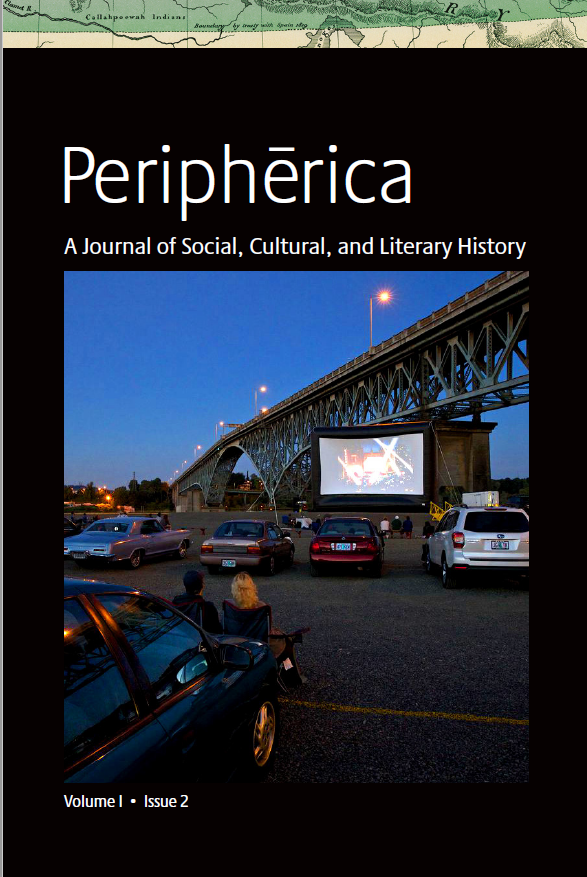<i>La guerre est finie</i> y/o <i>¿La guerra ha terminado?</i>: el filme de A. Resnais y Jorge Semprún y el papel que desempeña en la exposición permanente en el Centro de Arte Reina Sofía
DOI:
https://doi.org/10.5399/uo/peripherica.1.2.7Abstract
This article analyzes the ambiguity in the film La guerre est finie ([The War Is Over] 1966, director Alain Resnais, screenwriter Jorge Semprún) whose declarative title becomes a question in the title of the permanent exhibit at the Reina Sofía National Museum in Madrid: Is the War Over? Art in a Divided World (1945-1968). The works invite the viewer to question the nationalism that catapulted the Spanish Civil War, whose victory marked the first triumph for European fascisms and concomitant genocides. While the film entirely lacks symbols of irrefutable national identity, the paintings incorporate and subvert certain icons of (regional, Francoist, Nazi or Fascist) nationalism, as well as emblems of the Spanish Republic and Spain. The artworks respond in theme and form to nationalist ideology and esthetics. Although the film whose screenwriter Jorge Semprún had been imprisoned in the Nazi camp at Buchenwald—limits itself to implicit allusions to the eradication of the domestic enemy on Iberian soil and the so-called stateless undesirables exiled in foreign lands, the exhibit explicitly references Nazism and other 20th-century genocides.The collection of works exemplifies Aharon Appelfeld’s assertion: that only art has the ability to redeem suffering from the abyss. The film and the plastic works respond not only to nationalist ideologies and concomitant lived and witnessed experiences, but also to nationalist art. Through the visual counternarratives that give voice to myriad victimizations, these works make manifest and denounce, in theme and form, the anti-intellectualization and the fervent sentiment of political zeal.
References
Aguado, Txetxu. “Dissidence, Citizenry, and Witnessing: Three Screenplays by Jorge Semprún.” A Critical Companion to Jorge Semprún: Buchenwald Before and After. Eds. Gina Herrmann and Ofelia Ferrán. New York: Palgrave, 2014. 187-202.
Asociación Cultural Libre Configuración. “¿La guerra ha terminado? Arte en un mundo dividido (1945-1968).” https://lcmagazine.wordpress.com/2010/11/24/%C2%BFla-guerra-ha-terminado-arte-en-un-mundo-dividido-1945-1968/ (consultado 6 de febrero, 2015)
Baer, Alejandro y Natan Sznaider. Memory and Forgetting in the Post-Holocaust Era. London and New York: Routledge, 2017.
Bhabha, Homi. The Location of Culture. London and New York: Routledge, 1994.
Borja Villel, Manuel. “At the End of Utopia.” Is the War Over?: Art in a Divided World (1945-1968). Eds. Sonsoles Espinós, Amaia Múgica, Ruth Gallego. Madrid: Museo Nacional Centro de Arte Reina Sofía, 2010. 5-9.
Carrillo, Jesús y Rosario Peiró. “Introduction.” Is the War Over?: Art in a Divided World (1945-1968). Eds. Sonsoles Espinós, Amaia Múgica, Ruth Gallego. Madrid: Museo Nacional Centro de Arte Reina Sofía, 2010. 13-27.
Cayuela Gally, Ricardo. “Entrevista con Jorge Semprún: La memoria como escritura”. Letras Libres 5.60 (diciembre 2003). 37 (6).
http://find.galegroup.com/itx/infomark.do impreso 21 mayo, 2008.
Diamant, Naomi. The Boundaries of Holocaust Literature: The Emergence of a Canon. Dissertation. UMI: Columbia University, 1992.
Espinós, Sonsoles, Amaia Múgica, Ruth Gallego, eds. Is the War Over?: Art in a Divided World (1945-1968). Madrid: Museo Nacional Centro de Arte Reina Sofía, 2010.
Faber, Sebastiaan. “¿Usted, qué sabe?: History, Memory and the Voice of the Witness.” Revista Canadiense de Estudios Hispánicos 36, 1 (otoño 2011): 9-27.
Ferrán, Ofelia. “‘Cuanto más escribo, más me queda por decir’: Memory, Trauma, and Writing in the Work of Jorge Semprún”. MLN 116.2 Hispanic Issue (Mar. 2001): 266-94.
Ferrán, Ofelia and Gina Herrmann, eds. A Critical Companion to Jorge Semprún: Buchenwald Before and After. New York: Palgrave, 2014.
Ferrán, Ofelia and Gina Herrmann, eds. “Introduction.” A Critical Companion to Jorge Semprún: Buchenwald Before and After. New York: Palgrave, 2014. 1-36.
La guerre est finie. Dir. Alain Resnais. Guión Jorge Semprún. Europa Film.1966. DVD.
Hoy es arte. Com lc magazine.worldpress.com/2010/11/24/¿la-guerra-ha-terminado
Kaplan, Brett Ashley Kaplan. Unwanted Beauty: Aesthetic Pleasure in Holocaust Representation. Urbana and Chicago: U of Illinois Press, 2007.
Llorente Hernández, Ángel. Arte e ideología en el franquismo (1936-1951). Madrid: Visor, 1995.
Miletic, Tijana. “The Significance of Art in Semprún’s Writing.” In Critical Companion to Jorge Semprún: Buchenwald Before and After. Eds. Ofelia Ferrán and Gina Herrmann. New York: Palgrave, 2014.
Nicoladzé, Françoise. La deuxieme vie de Jorge Semprún. Une écriture tressée aux spirale de l’Histoire. Paris: Climats, 1998.
Nuit et brouillard. Dir. Alain Resnais. Argos Films. 1956. DVD.
Semprún, Jorge. La escritura o la vida. Barcelona: Tusquets, 1995.
------. La guerre est finie. Paris: 1966. Print.
------. El largo viaje. Barcelona: Tusquets, 2004 (1a edición Gallimard 1963).
------. Mal et modernité: Le travail de l’histoire. Paris: Editions Climats, 1990.
(Discurso presentado en la Sorbona el 19 de junio de 1990).
Vernon, Kathleen. “The Trauma of History/The History of Trauma: Plotting Memory in Jorge Semprún”. Cine-Lit III: Essays on Hispanic Film and Fiction. Eds. George Cabello-Castelet, Jaume Martí-Olivella y Guy Wood. Corvalis: Oregan State University, 1998. 157-67.
Obras de arte:
Monument aux espagnols morts pour la France (1946-47) de Pablo Picasso
Blau amb quatre barres roges (1966) de Antoni Tàpies
La puerta (1966) de Juan Genovés
Los cuatro dictadores (1963) de Eduardo Arroyo
España te miró (1967) de Eduardo Arroyo
¿La guerra ha terminado? (acceso virtual) http://www.museoreinasofia.es/coleccion/coleccion-2-la-guerra-ha-terminado-arte-en-un-mundo-dividido



